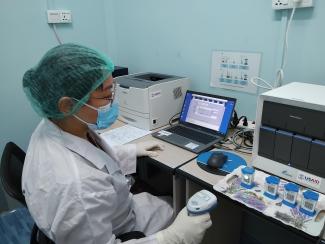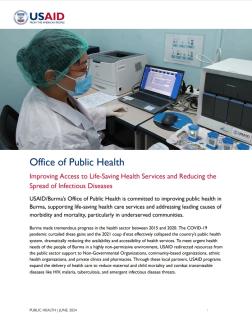Burma made tremendous progress in the health sector between 2015 and 2020. The COVID-19 pandemic curtailed these gains and the 2021 coup d’etat effectively collapsed the country’s public health system, dramatically reducing the availability and accessibility of health services. To meet urgent health needs of the people of Burma in a highly non-permissive environment, USAID redirected resources from the public sector support to Non-Governmental Organizations, community-based organizations, ethnic health organizations, and private clinics and pharmacies. Through these local partners, USAID programs expand the delivery of health care to reduce maternal and child mortality and combat transmissible diseases like HIV, malaria, tuberculosis, and emergent infectious disease threats.
Improving Access to Life-Saving Health Services
A healthy population is vital for a future democratic and prosperous Burma. Since the coup, health facilities and systems have experienced significant pressure, including a walkout of health professionals protesting the coup; physical attacks and raids of health facilities; and detainment of health professionals. USAID works closely with partners to strengthen the governance of local health systems and empower health outreach workers to respond to diverse health needs in their communities. Programs deliver life-saving health services to underserved and at-risk populations, and empower communities to advocate for their own health and well-being, adopt healthy behaviors, utilize life-saving health care services, and proactively engage with the health care sector to improve the quality of care.
Tuberculosis (TB)
TB is a leading cause of illness and premature death in Burma, and spreads primarily in densely populated urban centers. Since the coup, TB infections have increased by 17 percent, representing more than 200,000 people per year. USAID is expanding TB prevention, diagnostic, and treatment services by diversifying service delivery channels and linking clients to available services. Additionally, USAID is scaling-up innovative approaches; harnessing community workers, mobile clinics, networks of TB clients, and technology to bring services directly to patients.
Human Immunodeficiency Virus (HIV)
Burma is home to the third highest number of people living with HIV in Southeast Asia, an epidemic driven primarily by people who inject drugs, men who have sex with men, and sex workers. USAID provides comprehensive HIV prevention, care, and treatment services to at-risk populations and supports community-based groups to deliver services, including mental health and psychosocial support, directly to clients.
Malaria
In the decade before the coup, Burma made steady progress toward malaria elimination, but since the coup, cases have increased by 170 percent. Burma is now the only country in the region where malaria is on the rise. Working closely with partners, USAID implements a package of prevention, diagnostic, treatment, and surveillance interventions to stem the rise in malaria in 31 priority townships.
Maternal, Newborn and Child Health Care (MNCH)
Burma has the highest rate of maternal, newborn and child mortality in Southeast Asia. USAID is increasing the availability, affordability, and utilization of high-quality maternal, newborn, and child health services for vulnerable and underserved women and children through applied technologies, community workers, improved health facility standards, private sector and community engagement. Our programs deliver life-saving services, including antenatal care, skilled birth attendance, postnatal care, care for common childhood illnesses, childhood immunizations, and mental health service provision.


